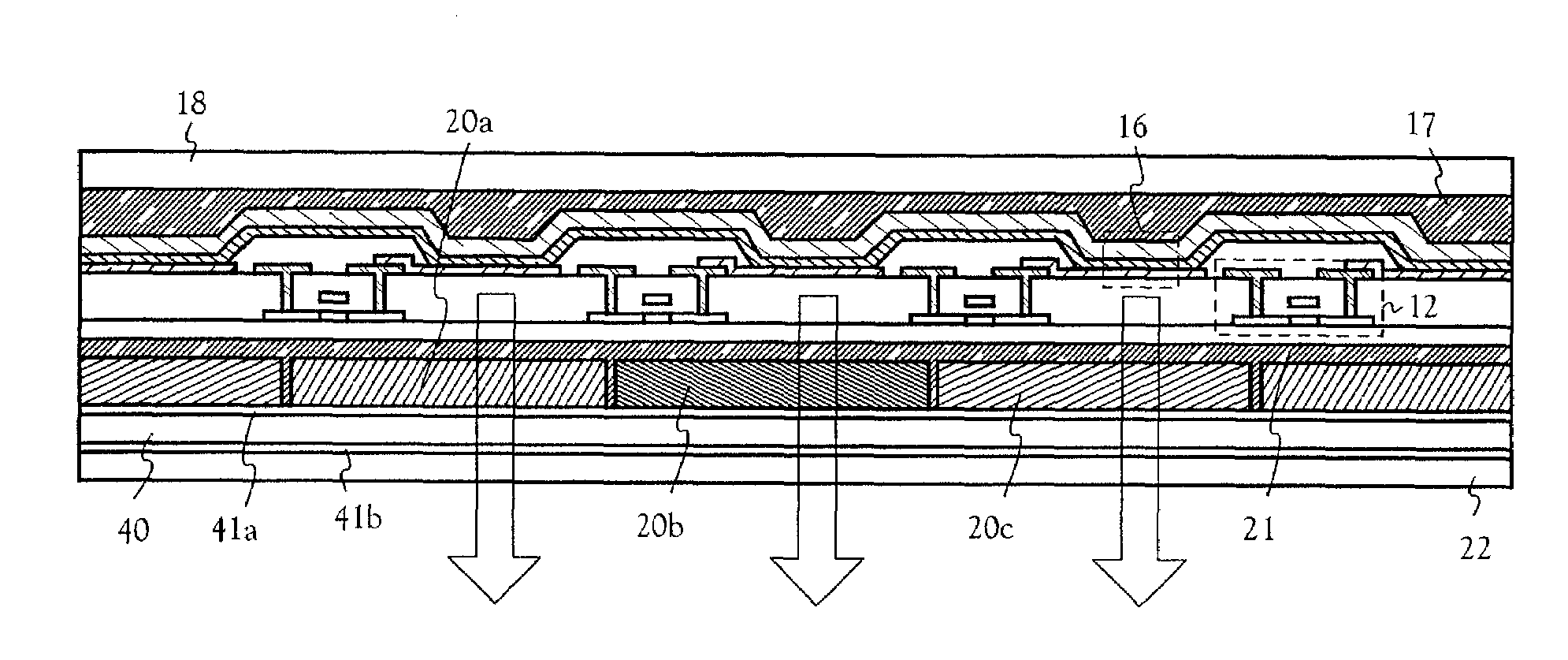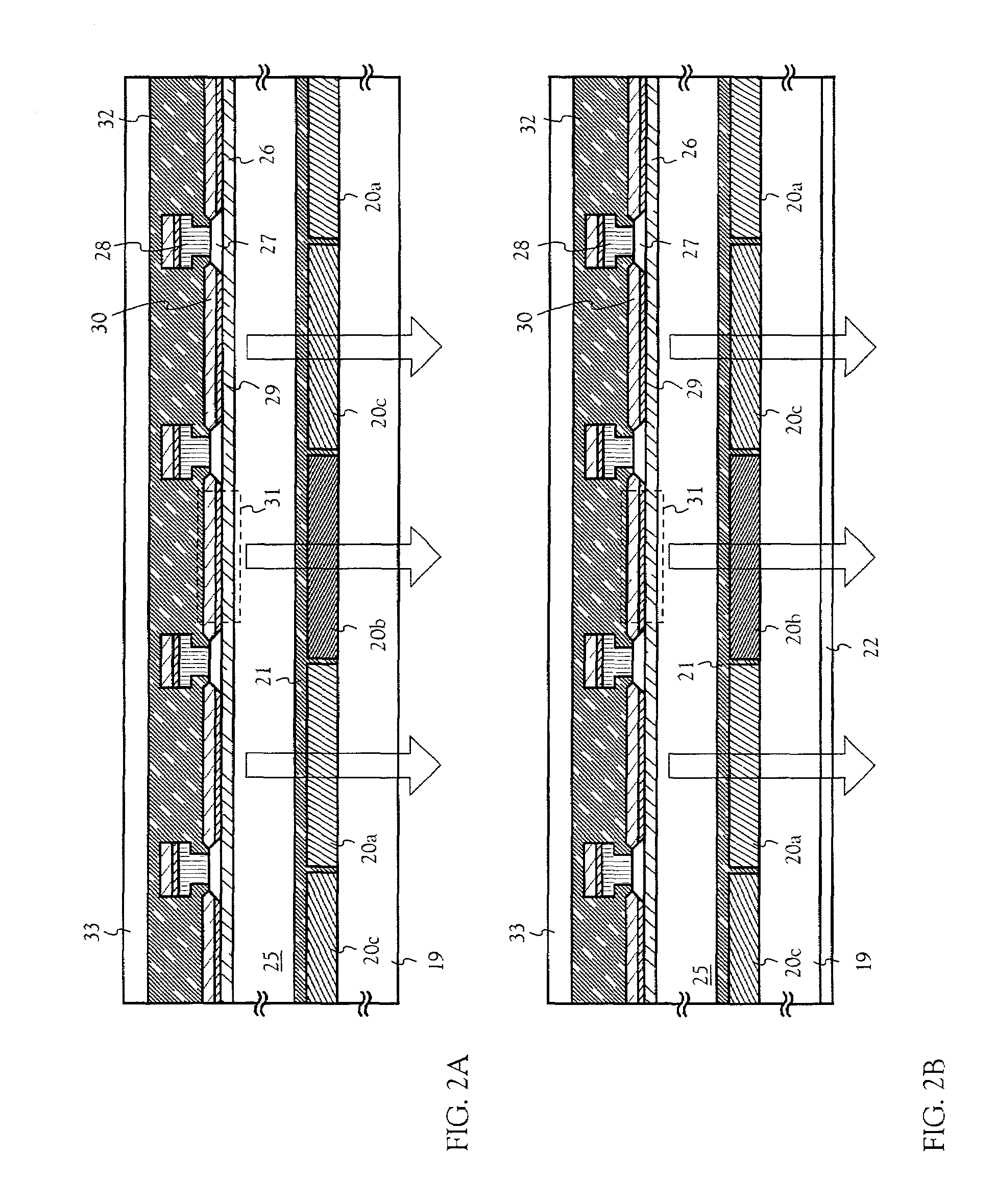Light emitting device
a technology light source, which is applied in the direction of semiconductor devices, diodes, electrical apparatus, etc., can solve the problems of significant reduction in the yield complicated manufacturing process of light emitting device, and unnecessary backlight used in liquid crystal display
- Summary
- Abstract
- Description
- Claims
- Application Information
AI Technical Summary
Benefits of technology
Problems solved by technology
Method used
Image
Examples
embodiment 1
[0056]In this embodiment, the case where the present invention is applied to a passive matrix type (simple matrix type) EL light emitting device will be described. Note that reference numerals identical to those used in FIGS. 1A and 1B may be referred to the descriptions in embodiment mode.
[0057]In FIG. 2A, reference numeral 25 denotes a glass substrate, and reference numeral 26 is an anode made of an oxide conductive film. In this embodiment, a compound film made of indium oxide and tin oxide is used as the oxide conductive film. Note that, in the anode 26, plural rectangular electrodes in which a direction from the left to the right in the paper is a longitudinal direction, are provided along a depth direction in the paper.
[0058]Also, a first bank member 27 and a second bank member 28, which are made from an insulating film are provided on the anode 26. In this embodiment, a silicon oxide film is used as the first bank member 27, and a resin film is used as the second bank member ...
embodiment 2
[0063]In the light emitting device as shown in FIGS. 1A and 1B or FIGS. 2A and 2B, after the active matrix substrate is completed, it is effective that the substrate on which an element has been formed is polished using a known CMP (chemical mechanical polishing) technique to make a thickness of the substrate thin. FIGS. 3A and 3B show a light emitting device according to this embodiment. Note that reference numerals identical to those used in FIGS. 1A and 1B or FIGS. 2A and 2B may be referred to the descriptions of embodiment mode.
[0064]In FIG. 3A, reference numeral 35 denotes a substrate polished by using the CMP technique, a structure except for this is similar to that of FIG. 1B. In this embodiment, a thickness of the substrate 35 is set as 300 μm or less (typically, 100 to 300 μm) by using the CMP technique. It is effective, for improving directivity of light, to make the thickness is set as a pixel pitch (distance from one pixel to next pixel) or less.
[0065]Also, FIG. 3B is an...
embodiment 3
[0067]In this embodiment, a description will be made of an example of a light emitting device shown in FIGS. 1A and 1B or FIGS. 2A and 2B, in which a plastic film (a film formed of polymeric material) is used as a color filter substrate. A light emitting device of this embodiment is shown in FIGS. 4A and 4B. Note that reference numerals identical to those used in FIGS. 1A and 1B or FIGS. 2A and 2B may be referred to the descriptions of embodiment mode.
[0068]In FIG. 4A, a color filter film 40 is a film (plastic film) formed of a polymeric material, and protective films 41a and 41b are formed on both (front and back surfaces) surfaces thereof. Note that, in this embodiment, a plastic film is used, but a substrate made of hard plastic may be used.
[0069]Further, as protective films 41a and 41b, it is preferable that an insulating film is provided, which does not permeate water or oxygen or which hardly permeate water or oxygen. Typically, a carbon film, preferably a diamond like carbon ...
PUM
 Login to View More
Login to View More Abstract
Description
Claims
Application Information
 Login to View More
Login to View More - R&D
- Intellectual Property
- Life Sciences
- Materials
- Tech Scout
- Unparalleled Data Quality
- Higher Quality Content
- 60% Fewer Hallucinations
Browse by: Latest US Patents, China's latest patents, Technical Efficacy Thesaurus, Application Domain, Technology Topic, Popular Technical Reports.
© 2025 PatSnap. All rights reserved.Legal|Privacy policy|Modern Slavery Act Transparency Statement|Sitemap|About US| Contact US: help@patsnap.com



